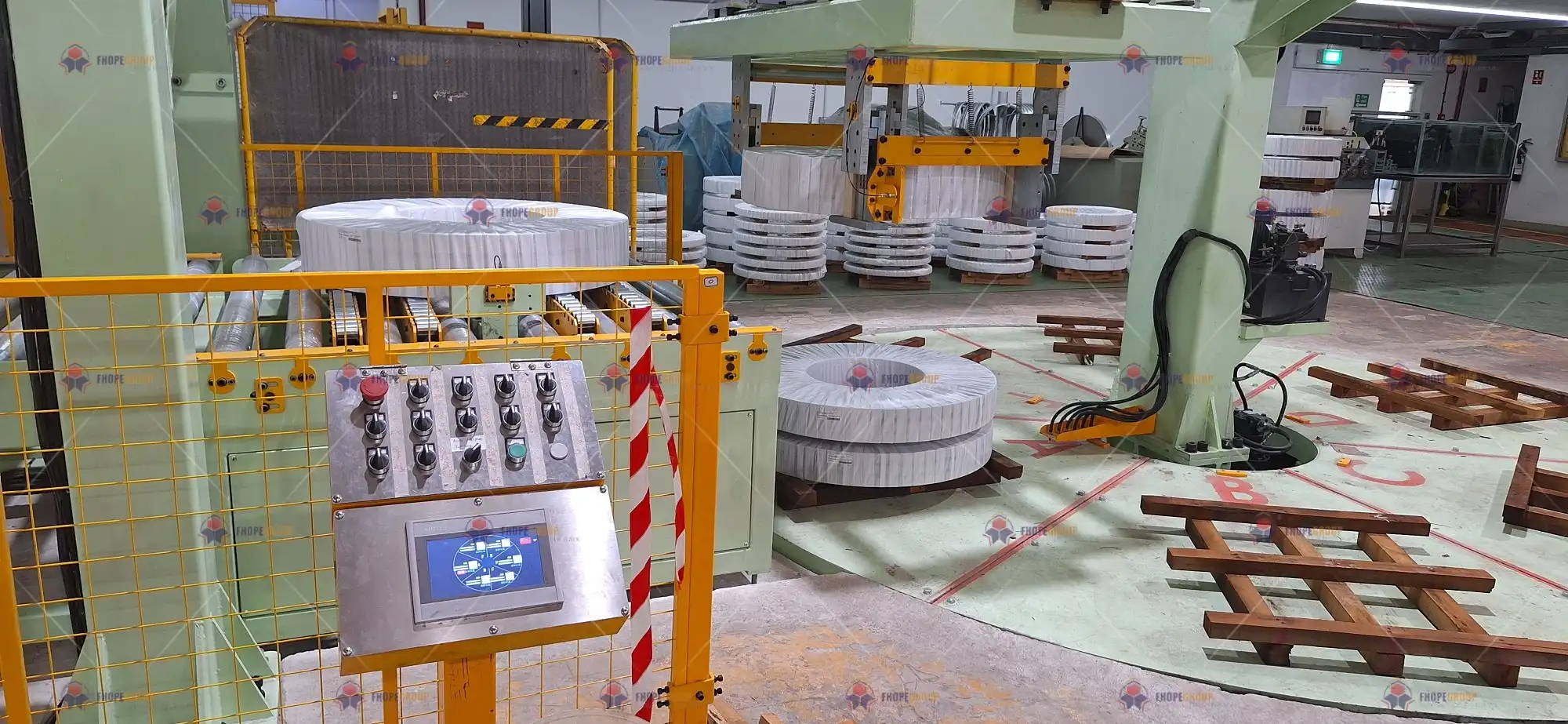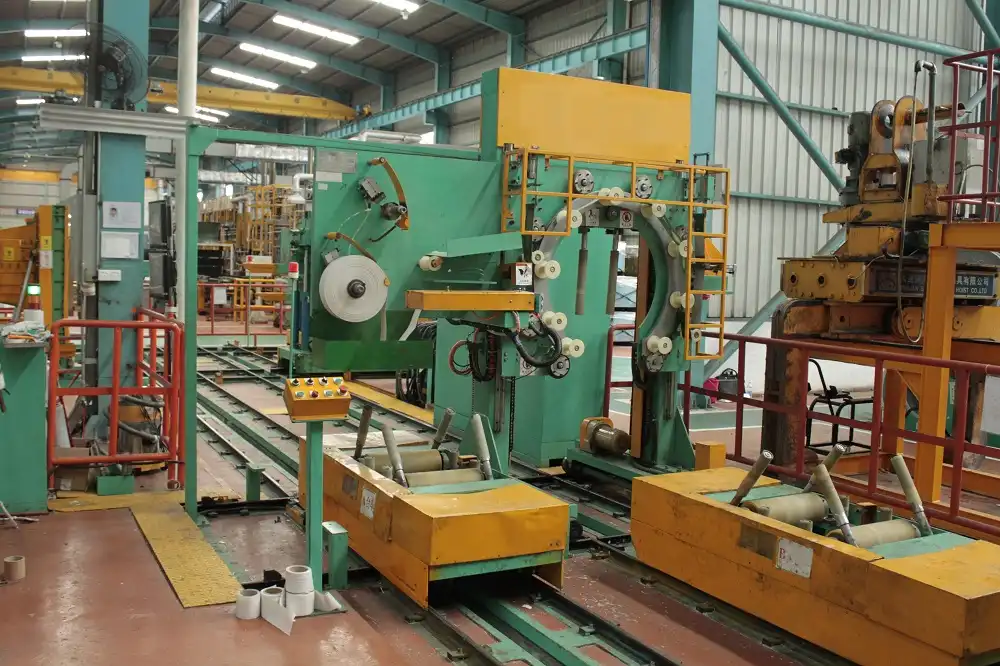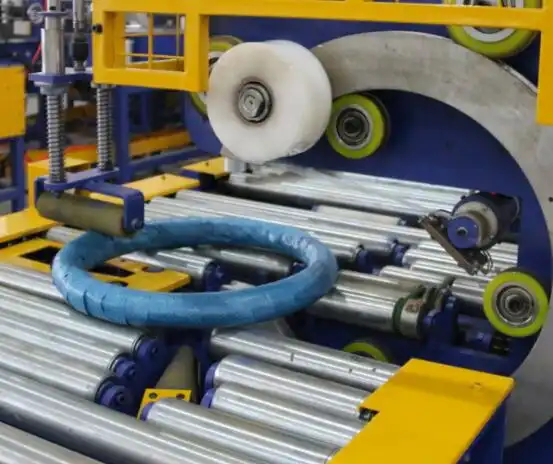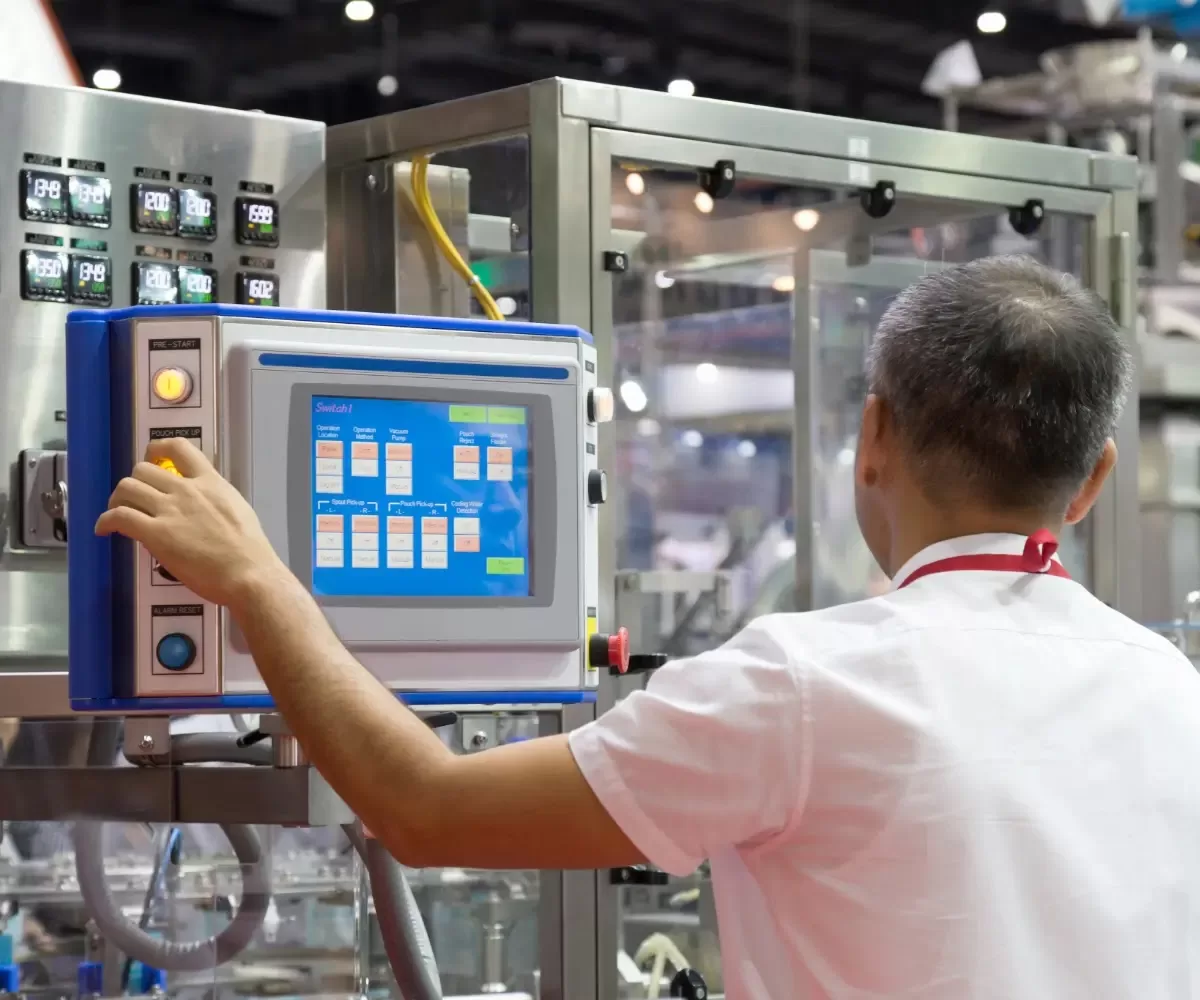Are you a factory manager struggling with outdated packaging methods? You probably see slow production lines, high labor costs, and the constant risk of worker injury eating into your profits. Every day feels like a battle to keep up, and the pressure to improve efficiency and safety is immense. It's frustrating when you know there has to be a better way, but past experiences with equipment suppliers have left you cautious and skeptical.
In 2025, savvy factory owners in major industrial markets like Russia are overwhelmingly choosing integrated and automated coil packaging lines. They are moving away from standalone, labor-intensive machines and investing in complete systems that combine coil tilting, conveying, wrapping, and stacking. This approach is their answer to boosting efficiency, drastically improving worker safety, and protecting their products from damage.

This shift isn't just a regional trend; it’s a global blueprint for success in the modern steel and metal processing industry. For a practical, results-driven manager like yourself, understanding the specifics behind these choices is key. It's not just about buying new machines. It's about investing in a solution that solves your deepest operational challenges. Let's break down exactly what these solutions are and why they provide such a powerful return on investment.
Why are they prioritizing integrated systems over standalone machines?
Does your factory floor feel like a collection of separate islands? You have a machine for one task, a team of workers for the next, and a constant bottleneck in between. This disjointed process leads to frustrating delays, communication breakdowns, and when something goes wrong, suppliers just point fingers at each other. Imagine instead a single, seamless system where every step flows perfectly into the next, all from a partner who understands your entire process.
They prioritize integrated systems because a single, cohesive line is the most effective way to eliminate bottlenecks. It drastically cuts down on the manual labor needed to move heavy coils between stations like tilting, wrapping, and strapping. This not only speeds up the entire process but also provides a single point of contact for service and support, which simplifies maintenance, troubleshooting, and overall management. It transforms a chaotic production end into a streamlined, predictable operation.

The Hidden Costs of a Disconnected "Frankenstein" Line
Many factories grow over time, adding machines piece by piece. You buy a wrapper from one company and a strapper from another. On the surface, this might seem like a cost-effective way to upgrade. But in my experience, this creates a "Frankenstein" line that has many hidden costs. The biggest issue is that the entire line can only run as fast as its slowest part, which is almost always the manual step of moving a coil from one machine to the next. You might have a high-speed wrapper, but if it takes two workers a full minute to get the next coil into position, the wrapper sits idle most of the time.
I remember a client in a situation much like this. He had a great wrapping machine, but his manual strapping and weighing process created a huge backlog. His expensive wrapper was only running at 40% capacity. The problem wasn't one single machine; it was the lack of flow between the machines. Integration issues are also a major headache. Getting machines from different suppliers to "talk" to each other can be complex and expensive. When a problem occurs, the wrapper supplier blames the conveyor, and the conveyor supplier blames the strapper. You, the manager, are stuck in the middle, trying to solve a problem that no one will take ownership of.
| Feature | Standalone Machines | Integrated System |
|---|---|---|
| Throughput | Limited by the slowest manual step | Optimized for continuous, predictable flow |
| Labor Requirement | High for transferring coils between stages | Minimal, focused on supervision not manual work |
| Factory Footprint | Often large and inefficiently laid out | Compact and purpose-designed for flow |
| Accountability | Multiple suppliers, potential for blame-shifting | Single supplier, one point of contact for all issues |
| Integration | Complex, costly, and often unreliable | Seamless, designed to work together from day one |
The Strategic Advantage of a Cohesive Flow
An integrated system, on the other hand, is designed from the ground up to work as a single unit. It’s like a well-rehearsed orchestra instead of a bunch of solo musicians. The coil tilter receives the coil and smoothly places it on the conveyor. The conveyor moves it perfectly into the wrapping station. The wrapper completes its cycle and sends it to the stacking or strapping station. Every step is timed and automated. This creates a smooth, continuous flow that maximizes your throughput and minimizes the chance of error or damage. For a manager focused on efficiency, this predictable output is invaluable. It allows for better production planning, more accurate delivery schedules, and ultimately, a more profitable operation.
How does automation specifically address safety and reduce labor costs?
Think about the most dangerous jobs on your factory floor. They almost always involve manually moving, lifting, or flipping heavy, awkward materials. The risk of a back injury, a crushed foot, or worse is always present. The cost of just one serious accident—in medical bills, insurance hikes, lost productivity, and damaged morale—can be staggering. What if you could engineer that risk away, creating a safer environment for your team while also lowering costs?
Automation directly addresses safety by taking people out of the danger zone. It replaces the most physically demanding and hazardous manual tasks with reliable machinery. This fundamentally reduces the risk of musculoskeletal injuries, slips, and accidents associated with handling heavy coils. As a direct result, you can lower your insurance premiums and improve employee retention. At the same time, it reduces the number of operators needed per shift, cutting direct labor costs and allowing you to reassign your skilled workers to more valuable roles like quality control or maintenance.

From High-Risk to Low-Risk: A Task-by-Task Transformation
Let's get specific about the tasks that automation transforms. In a typical manual or semi-manual process, workers are exposed to risk at several key points. An automated line replaces these high-risk actions with safe, mechanical precision.
- Coil Tilting: Manually flipping a steel coil, even with a crane, is a high-risk maneuver. One slip can be catastrophic. An automated coil tilter, or upender, securely grips the coil and rotates it 90 degrees in a controlled, predictable motion. It removes the human element from one of the most dangerous jobs in the entire process.
- Coil Transport: In many factories, the floor is a busy and dangerous place, with forklifts constantly moving heavy loads. This creates a huge potential for collisions with people or structures. An automated conveyor system creates a dedicated, predictable path for coils. It eliminates the need for forklift traffic in the packaging area, making the entire workspace significantly safer.
- Wrapping and Strapping: Manually wrapping a large coil with stretch film is physically exhausting. It involves walking backward in circles while pulling a heavy roll of film, leading to fatigue, repetitive strain injuries, and inconsistent wrap quality. An orbital wrapping machine does this job perfectly every time, with no physical strain on an operator. The operator's job shifts from manual laborer to system supervisor.
The True Cost of Labor is More Than a Paycheck
When we talk about reducing labor costs, it’s not just about the salary you pay an employee. The true cost includes recruitment and training, health insurance, workers' compensation insurance, payroll taxes, and paid time off. It also includes the indirect costs of human error, such as product damage or inconsistent packaging that leads to customer complaints. When you automate a process, you're not just saving on a salary; you're reducing all these associated costs.
For a manager who oversees a team that manually packs 50 coils a day, automating the process could free up two to three workers per shift. This isn't about firing people. It’s about reallocating your valuable human resources. Those experienced workers can be retrained for higher-value jobs that automation can't do, like performing preventative maintenance, overseeing quality control, or operating more complex machinery. This leads to a more skilled, more engaged, and more stable workforce. I've seen firsthand how factories that invest in automation not only cut costs but also see their employee turnover rate drop significantly.
What features are essential for durability in a high-demand steel factory?
You’ve probably experienced this before. You buy a new piece of equipment that looks impressive in the catalog and works well during the demo. But six months later, on your demanding factory floor, it starts to fail. Constant breakdowns, frequent repairs, and long waits for spare parts are not just frustrating—they cost you money every minute your line is down. How can you be sure that a new machine is truly built to last in your tough environment?
For real durability in a high-demand steel factory, you must look past the paint job. The essential, non-negotiable features include a heavy-duty, welded steel frame, not a bolted one. It requires the use of high-quality, globally recognized components like Siemens PLCs, SEW motors, and SKF bearings. The machine must have oversized motors and gearboxes that can handle the stress of continuous operation. These core elements are what ensure a machine can withstand constant vibration, heavy loads, and the abrasive, dusty environment of a metal processing plant for years to come.

It All Starts with the Frame: The Unseen Foundation
The single most important indicator of a machine's durability is its frame. A machine that handles multi-ton steel coils day in and day out is under immense physical stress. A light-duty, bolted frame will inevitably loosen over time due to constant vibration. This leads to misalignment, increased wear on moving parts, and eventual failure. A heavy-duty frame, constructed from thick steel plates and fully welded at the seams, provides a rigid and stable foundation that will not warp or shift.
This is a lesson I learned the hard way when I was building my own factory. I tried to save some money on a machine with a bolted frame. It looked fine at first, but within a year, it was vibrating so much that it was literally shaking itself apart. We were constantly tightening bolts and realigning components. It was a maintenance nightmare. For a manager running high-intensity, multi-shift operations, a solid, welded structure isn't a luxury; it's the absolute baseline for reliability. When you are evaluating a machine, ask the supplier about the steel thickness and the construction method. It tells you everything about their commitment to quality.
The Components That Make or Break a Machine
A great frame is just the start. The components inside the machine are what do the work, and their quality will determine its reliability and ease of maintenance. Using cheap, no-name components is the fastest way for a manufacturer to cut costs, but it passes all the risk on to you. A breakdown of a critical component can shut down your entire line. If that part is hard to source, you could be down for days or even weeks. That’s why insisting on reputable, brand-name components is so important.
| Component | What to Look For (Examples) | Why It Matters for Durability & ROI |
|---|---|---|
| PLC / Control System | Siemens, Allen-Bradley, Omron | Rock-solid reliability, easy to find local technicians who can program and troubleshoot them, global support. |
| Motors / Gearboxes | SEW-Eurodrive, Siemens, Nord | Designed for continuous, heavy-duty cycles. They are energy-efficient and have the power to handle peak loads without burning out. |
| Bearings | SKF, FAG, NSK, Timken | High-quality bearings are crucial for any rotating part, like the main wrapping ring. They reduce friction, wear, and heat, leading to a much longer service life. |
| Pneumatics / Hydraulics | Festo, SMC, Parker | Reliable valves and cylinders prevent leaks and ensure consistent, repeatable movements, which is critical for safety and precision. |
| Sensors | SICK, Banner, Keyence | Accurate and durable sensors are the "eyes" of the machine. They ensure correct positioning, prevent crashes, and are vital for safety functions. |
When a supplier uses these types of components, it's a strong signal that they are building a machine to last, not just to sell. It also means that when you do need a spare part down the road, you can likely source it locally instead of waiting for an expensive shipment from overseas.
How can you ensure a new packaging line delivers a real ROI?
You know you need to upgrade your packaging line, but making a large capital investment is a huge responsibility. You feel the pressure from upper management to justify the expense, and after being burned by suppliers in the past, you're rightfully cautious. You can't afford to invest in another "solution" that fails to deliver on its promises. The key isn't just to buy a machine; it's to find a partner who helps you build a rock-solid business case before you spend a single dollar.
To ensure a new packaging line delivers a real Return on Investment (ROI), you must look far beyond the initial purchase price. A true partner will work with you to analyze your Total Cost of Ownership (TCO). This includes a detailed calculation of your savings in labor, the financial benefit of increased throughput, the money saved by reducing product damage, and the long-term value of improved safety. They should provide a clear, conservative ROI projection based on your factory's specific data, not on generic marketing claims.

The ROI Calculation: A Tool for Smart Decisions
An ROI calculation shouldn't be a mystery. It's a straightforward tool to help you see if an investment makes financial sense. A trustworthy supplier should be eager to walk you through it. Here's how we break it down for our clients:
1. The Investment (I): This is the total upfront cost. It’s not just the machine price. It must include shipping, installation, and the cost of training your team to operate and maintain the new equipment.
2. The Return (R): This is where the real analysis happens. We look at several areas of your operation to quantify the annual savings:
- Labor Savings: This is the easiest to calculate. We take the number of workers who can be reassigned and multiply it by their fully-loaded annual cost (salary + benefits + insurance + taxes).
- Increased Throughput: If your current line produces 50 coils per shift and the new line can produce 80, that’s 30 extra coils. We multiply that by your net profit per coil to find the added revenue.
- Reduced Product Damage: You know how much money you lose each year to coils with damaged edges or improper packaging. If a new automated line can cut that damage by 80-90%, that's a direct saving to your bottom line.
- Improved Safety: This is harder to quantify, but it's real. We can look at the potential reduction in your workers' compensation insurance premium. More importantly, we consider the massive avoided cost of even a single serious accident.
The final ROI is calculated over a period, usually expressed in months: Investment / (Annual Return / 12) = Months to Payback. A payback period of 18-36 months is often a very strong justification for the investment.
A True Partner vs. a Simple Salesperson
This process is what separates a true solutions partner from a simple equipment salesperson. A salesperson sells you a machine. A partner helps you solve a business problem. This is deeply personal for me. When I founded my own factory, I wasn't just buying equipment; I was betting my family's financial future on those decisions. I know the weight of that responsibility.
That's why at SHJLPACK, our process always starts with listening. We want to understand your specific challenges—your bottlenecks, your safety concerns, your damage rates. We don't just send a generic quote. We ask for your operational data because we want to prove the value of our solution on paper before you commit. If the numbers don't work for you, we will be the first to tell you. Building that trust is more important to us than making a single sale. A partner is invested in your success because your success becomes a testament to their expertise. This approach directly addresses the supplier trust crisis that many experienced managers have faced.
Conclusion
Investing in an integrated, durable, and automated coil packaging line is a strategic move for long-term efficiency, safety, and profitability in your factory.




